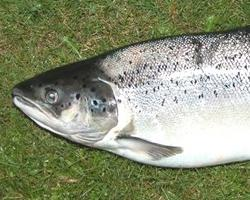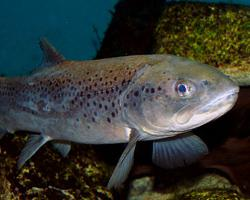
Veszélyeztetettség
| Veszélyeztetett |
Állatleírás
The Sea trout, scientifically known as Salmo trutta morpha trutta, is a fascinating and complex fish that belongs to the salmon family Salmonidae. It is an anadromous form of the brown trout (Salmo trutta) that has adapted to a life split between freshwater and the sea. This migratory behavior is a defining characteristic of the species, influencing its lifecycle, habitat, and even physical appearance.Adult Sea trout typically spend the majority of their life in coastal waters, only returning to freshwater streams and rivers to spawn. This migration is instinctual and plays a crucial role in their reproductive cycle. They usually embark on this journey during the night, using the cover of darkness as protection against predators. The timing of their migration can vary significantly depending on geographical location, but it generally occurs when the water temperature and flow conditions are optimal for spawning.
The physical appearance of Sea trout can be quite variable, but they generally exhibit a sleek, streamlined body that is well-adapted for both their freshwater and marine environments. Their coloration can also vary but often includes a silvery hue when they are in the sea, which helps to camouflage them from predators. As they return to freshwater for spawning, their coloration can shift to more closely resemble that of freshwater brown trout, with a more pronounced spotting pattern and a darker back.
Sea trout can grow to be quite large, with some individuals reaching lengths of up to 90 cm (35 inches) and weights of several kilograms. However, the size of the fish can vary significantly based on their habitat and the availability of food sources. In the marine environment, Sea trout primarily feed on small fish, crustaceans, and mollusks, while their diet in freshwater can include insects, larvae, and small invertebrates.
The lifecycle of the Sea trout is one of survival and adaptation. After hatching from eggs laid in freshwater, the juvenile trout, known as parr, will spend the first few years of their life in the river. During this time, they undergo significant physiological changes that prepare them for life in saltwater, a process known as smoltification. Once they have transformed into smolts and migrated to the sea, they face a new set of challenges, including predation from larger fish and navigating vast marine environments.
Conservation efforts are crucial for the survival of Sea trout populations, as they face threats from habitat destruction, pollution, and overfishing. Restoring river habitats, implementing sustainable fishing practices, and monitoring population levels are all important steps in ensuring the future of this remarkable species.
In summary, the Sea trout (Salmo trutta morpha trutta) is a migratory fish of great ecological and biological interest. Its lifecycle, which spans both freshwater and marine environments, is a testament to the adaptability and resilience of this species. With their silvery scales, impressive migrations, and complex life history, Sea trout continue to captivate the interest of scientists, conservationists, and anglers alike.
Hasonló állatok
Új állatfotók
Top 10 állat
- Dolphin gull (Leucophaeus scoresbii)
- Japanese macaque (Macaca fuscata)
- Stone loach (Barbatula barbatula)
- Galápagos tortoise (Geochelone nigra complex)
- Russian tortoise (Testudo horsfieldii)
- Greek tortoise (Testudo graeca)
- Diana monkey (Cercopithecus diana)
- Moustached guenon (Cercopithecus cephus)
- Common flying dragon (Draco volans)
- Galápagos penguin (Spheniscus mendiculus)


